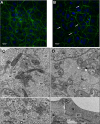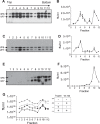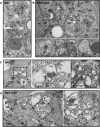Actin-Dependent Nonlytic Rotavirus Exit and Infectious Virus Morphogenetic Pathway in Nonpolarized Cells
- PMID: 29263265
- PMCID: PMC5827380
- DOI: 10.1128/JVI.02076-17
Actin-Dependent Nonlytic Rotavirus Exit and Infectious Virus Morphogenetic Pathway in Nonpolarized Cells
Abstract
During the late stages of rotavirus morphogenesis, the surface proteins VP4 and VP7 are assembled onto the previously structured double-layered virus particles to yield a triple-layered, mature infectious virus. The current model for the assembly of the outer capsid is that it occurs within the lumen of the endoplasmic reticulum. However, it has been shown that VP4 and infectious virus associate with lipid rafts, suggesting that the final assembly of the rotavirus spike protein VP4 involves a post-endoplasmic reticulum event. In this work, we found that the actin inhibitor jasplakinolide blocks the cell egress of rotavirus from nonpolarized MA104 cells at early times of infection, when there is still no evidence of cell lysis. These findings contrast with the traditional assumption that rotavirus is released from nonpolarized cells by a nonspecific mechanism when the cell integrity is lost. Inspection of the virus present in the extracellular medium by use of density flotation gradients revealed that a fraction of the released virus is associated with low-density membranous structures. Furthermore, the intracellular localization of VP4, its interaction with lipid rafts, and its targeting to the cell surface were shown to be prevented by jasplakinolide, implying a role for actin in these processes. Finally, the VP4 present at the plasma membrane was shown to be incorporated into the extracellular infectious virus, suggesting the existence of a novel pathway for the assembly of the rotavirus spike protein.IMPORTANCE Rotavirus is a major etiological agent of infantile acute severe diarrhea. It is a nonenveloped virus formed by three concentric layers of protein. The early stages of rotavirus replication, including cell attachment and entry, synthesis and translation of viral mRNAs, replication of the genomic double-stranded RNA (dsRNA), and the assembly of double-layered viral particles, have been studied widely. However, the mechanisms involved in the later stages of infection, i.e., viral particle maturation and cell exit, are less well characterized. It has been assumed historically that rotavirus exits nonpolarized cells following cell lysis. In this work, we show that the virus exits cells by a nonlytic, actin-dependent mechanism, and most importantly, we describe that VP4, the spike protein of the virus, is present on the cell surface and is incorporated into mature, infectious virus, indicating a novel pathway for the assembly of this protein.
Keywords: cell exit; morphogenesis; rotavirus; virus assembly.
Copyright © 2018 American Society for Microbiology.
Figures










Similar articles
-
Rafts promote assembly and atypical targeting of a nonenveloped virus, rotavirus, in Caco-2 cells.J Virol. 2002 May;76(9):4591-602. doi: 10.1128/jvi.76.9.4591-4602.2002. J Virol. 2002. PMID: 11932424 Free PMC article.
-
Dissecting rotavirus particle-raft interaction with small interfering RNAs: insights into rotavirus transit through the secretory pathway.J Virol. 2006 Apr;80(8):3935-46. doi: 10.1128/JVI.80.8.3935-3946.2006. J Virol. 2006. PMID: 16571810 Free PMC article.
-
Silencing the morphogenesis of rotavirus.J Virol. 2005 Jan;79(1):184-92. doi: 10.1128/JVI.79.1.184-192.2005. J Virol. 2005. PMID: 15596814 Free PMC article.
-
Rotavirus Replication: Gaps of Knowledge on Virus Entry and Morphogenesis.Tohoku J Exp Med. 2019 Aug;248(4):285-296. doi: 10.1620/tjem.248.285. Tohoku J Exp Med. 2019. PMID: 31447474 Review.
-
Rotavirus assembly: an alternative model that utilizes an atypical trafficking pathway.Curr Top Microbiol Immunol. 2006;309:245-61. doi: 10.1007/3-540-30773-7_9. Curr Top Microbiol Immunol. 2006. PMID: 16909902 Free PMC article. Review.
Cited by
-
Porcine rotavirus mainly infects primary porcine enterocytes at the basolateral surface.Vet Res. 2019 Dec 19;50(1):110. doi: 10.1186/s13567-019-0728-x. Vet Res. 2019. PMID: 31856906 Free PMC article.
-
The C Terminus of Rotavirus VP4 Protein Contains an Actin Binding Domain Which Requires Cooperation with the Coiled-Coil Domain for Actin Remodeling.J Virol. 2018 Dec 10;93(1):e01598-18. doi: 10.1128/JVI.01598-18. Print 2019 Jan 1. J Virol. 2018. PMID: 30333172 Free PMC article.
-
The actin cytoskeleton is important for rotavirus internalization and RNA genome replication.Virus Res. 2019 Apr 2;263:27-33. doi: 10.1016/j.virusres.2019.01.003. Epub 2019 Jan 9. Virus Res. 2019. PMID: 30639190 Free PMC article.
-
Recent advances in rotavirus reverse genetics and its utilization in basic research and vaccine development.Arch Virol. 2021 Sep;166(9):2369-2386. doi: 10.1007/s00705-021-05142-7. Epub 2021 Jul 3. Arch Virol. 2021. PMID: 34216267 Free PMC article. Review.
-
Rotavirus Spike Protein VP4 Mediates Viroplasm Assembly by Association to Actin Filaments.J Virol. 2022 Sep 14;96(17):e0107422. doi: 10.1128/jvi.01074-22. Epub 2022 Aug 8. J Virol. 2022. PMID: 35938869 Free PMC article.
References
-
- Estes MK, Greenberg HB. 2013. Rotaviruses, p 1347–1401. In Knipe DM, Howley PM, Cohen JI, Griffin DE, Lamb RA, Martin MA, Racaniello VR, Roizman B (ed), Fields virology, 6th ed Lippincott Williams & Wilkins, Philadelphia, PA.
-
- Li B, Ding S, Feng N, Mooney N, Ooi YS, Ren L, Diep J, Kelly MR, Yasukawa LL, Patton JT, Yamazaki H, Shirao T, Jackson PK, Greenberg HB. 2017. Drebrin restricts rotavirus entry by inhibiting dynamin-mediated endocytosis. Proc Natl Acad Sci U S A 114:E3642–E3651. doi:10.1073/pnas.1619266114. - DOI - PMC - PubMed
Publication types
MeSH terms
Substances
LinkOut - more resources
Full Text Sources
Other Literature Sources
Medical

